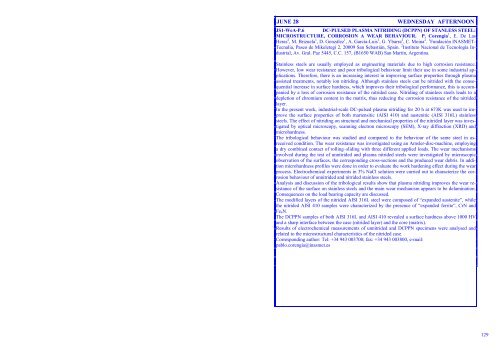Wüest M. 51 Wykes M. 82 Yamaguchi M. 17 Ybarra G. 129 Yubero F ...
Wüest M. 51 Wykes M. 82 Yamaguchi M. 17 Ybarra G. 129 Yubero F ...
Wüest M. 51 Wykes M. 82 Yamaguchi M. 17 Ybarra G. 129 Yubero F ...
Create successful ePaper yourself
Turn your PDF publications into a flip-book with our unique Google optimized e-Paper software.
JUNE 28 WEDNESDAY AFTERNOON<br />
JS1-WeA-P.6 DC-PULSED PLASMA NITRIDING (DCPPN) OF STANLESS STEEL:<br />
MICROSTRUCTURE, CORROSION A WEAR BEHAVIOUR. P. Corengia 1 , E. De Las<br />
Heras 2 , M. Brizuela 1 , D. González 1 , A. García-Luis 1 , G. <strong>Ybarra</strong> 2 , C. Moina 2 . 1 Fundación INASMET-<br />
Tecnalia, Paseo de Mikeletegi 2, 20009 San Sebastián, Spain. 2 Instituto Nacional de Tecnología Industrial,<br />
Av. Gral. Paz 5445, C.C. 157, (B1650 WAB) San Martín, Argentina.<br />
Stainless steels are usually employed as engineering materials due to high corrosion resistance.<br />
However, low wear resistance and poor tribological behaviour limit their use in some industrial applications.<br />
Therefore, there is an increasing interest in improving surface properties through plasma<br />
assisted treatments, notably ion nitriding. Although stainless steels can be nitrided with the consequential<br />
increase in surface hardness, which improves their tribological performance, this is accompanied<br />
by a loss of corrosion resistance of the nitrided case. Nitriding of stainless steels leads to a<br />
depletion of chromium content in the matrix, thus reducing the corrosion resistance of the nitrided<br />
layer.<br />
In the present work, industrial-scale DC-pulsed plasma nitriding for 20 h at 673K was used to improve<br />
the surface properties of both martensitic (AISI 410) and austenitic (AISI 316L) stainless<br />
steels. The effect of nitriding on structural and mechanical properties of the nitrided layer was investigated<br />
by optical microscopy, scanning electron microscopy (SEM), X-ray diffraction (XRD) and<br />
microhardness.<br />
The tribological behaviour was studied and compared to the behaviour of the same steel in asreceived<br />
condition. The wear resistance was investigated using an Amsler-disc-machine, employing<br />
a dry combined contact of rolling–sliding with three different applied loads. The wear mechanisms<br />
involved during the test of unnitrided and plasma nitrided steels were investigated by microscopic<br />
observation of the surfaces, the corresponding cross-sections and the produced wear debris. In addition<br />
microhardness profiles were done in order to evaluate the work hardening effect during the wear<br />
process. Electrochemical experiments in 3% NaCl solution were carried out to characterize the corrosion<br />
behaviour of unnitrided and nitrided stainless steels.<br />
Analysis and discussion of the tribological results show that plasma nitriding improves the wear resistance<br />
of the surface on stainless steels and the main wear mechanism appears to be delamination.<br />
Consequences on the load bearing capacity are discussed.<br />
The modified layers of the nitrided AISI 316L steel were composed of “expanded austenite”, while<br />
the nitrided AISI 410 samples were characterized by the presence of “expanded ferrite”, CrN and<br />
Fe 4 N.<br />
The DCPPN samples of both AISI 316L and AISI 410 revealed a surface hardness above 1000 HV<br />
and a sharp interface between the case (nitrided layer) and the core (matrix).<br />
Results of electrochemical measurements of unnitrided and DCPPN specimens were analysed and<br />
related to the microstructural characteristics of the nitrided case.<br />
Corresponding author: Tel: +34 943 003700; fax: +34 943 003800, e-mail:<br />
pablo.corengia@inasmet.es<br />
<strong>129</strong>
















